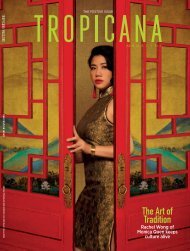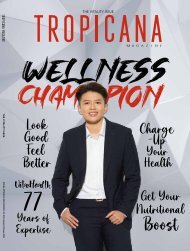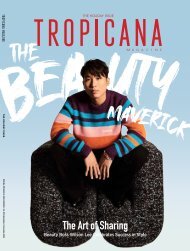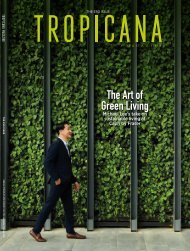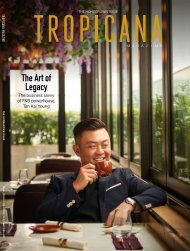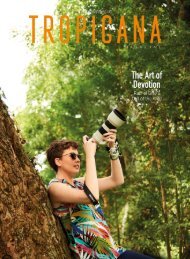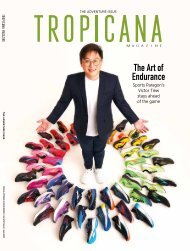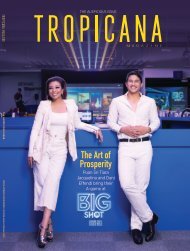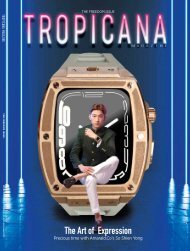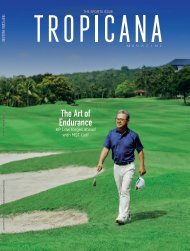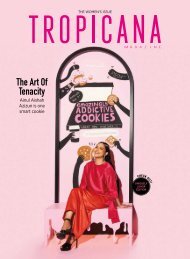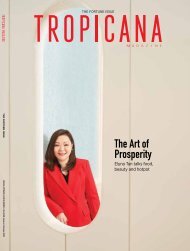Tropicana Jan-Feb 2018 #116 A Start from the Heart
- No tags were found...
Create successful ePaper yourself
Turn your PDF publications into a flip-book with our unique Google optimized e-Paper software.
THE HOME | natural selection<br />
The elements are ano<strong>the</strong>r important ingredient in<br />
Kuma’s work – wind, temperature, humidity and most<br />
importantly light. Employing a technique adapted <strong>from</strong><br />
<strong>the</strong> traditional Japanese home or minka which lacks<br />
windows but instead used paper and rice straw to filter<br />
sun and moonlight; Kuma’s firm manipulates materials<br />
in unlikely ways to achieve <strong>the</strong> same effect.<br />
Among his most ingenious solutions has been <strong>the</strong> use<br />
of translucent walls. Creating bricks <strong>from</strong> polyethylene<br />
plastic, his firm created what appeared to be building<br />
blocks for a private member’s club in Beijing. If it were<br />
anywhere else it would have looked awkward and out of<br />
place but set within striking distance of <strong>the</strong> Forbidden<br />
City, <strong>the</strong> Beijing Tea House simultaneously stood out and<br />
adapted to its surroundings.<br />
A similar effect was used for a Japanese furniture<br />
manufacturer, this time using moulded ETFE plastic to<br />
create undulating outer walls and transparent PVC and<br />
mesh for its inner walls. This exploitation of natural<br />
light and <strong>the</strong> insulating properties of <strong>the</strong> materials<br />
additionally reduced energy use, which is an important<br />
consideration – after all, architecture and design are not<br />
merely about form but function.<br />
Beguiling as his work is, it is <strong>the</strong>re to solve a<br />
problem. His technique of chequering, criss-crossing<br />
and lattices on facades, and repetitive patterns and use of<br />
textures, do this with aplomb. One need look no fur<strong>the</strong>r<br />
than <strong>the</strong> Suntory Museum Of Art in Tokyo whose quiet<br />
minimalism creates a sense of space and calm, its moods<br />
changing with <strong>the</strong> time of day and seasons.<br />
By fashioning forms <strong>from</strong> materials, bending and<br />
folding in <strong>the</strong> style of origami, his structures are strong<br />
and beautiful. Take, for example, his use of perforated<br />
aluminium mesh on <strong>the</strong> exterior of <strong>the</strong> award-winning<br />
Hongkou Soho building in Shanghai. Resembling soft<br />
draping, like a skirt twirling at <strong>the</strong> ankles of some<br />
debutante, it appears to morph according to <strong>the</strong> pattern<br />
of light striking it.<br />
Regional Fund for<br />
Contemporary Art (Frac)<br />
of <strong>the</strong> Provence-Alpes-<br />
Côtes d’Azur (PACA)<br />
“It is this<br />
reinterpretation<br />
of traditional<br />
practices for <strong>the</strong><br />
21st century that<br />
has marked Kuma’s<br />
practice out <strong>from</strong><br />
o<strong>the</strong>rs and can be<br />
seen in <strong>the</strong> use of<br />
materials and his<br />
manipulation of<br />
<strong>the</strong>m.”<br />
TM | january/february <strong>2018</strong><br />
46



